The Cold War began and ended in Europe, though in between it was at its bloodiest and most intense elsewhere. The continent itself was congealed into two blocs, each led by the superpower on its periphery. American and Soviet ideology and culture were steeped in European heritage, but neither was seen as entirely of Europe, least of all by their respective detractors. As the Cold War approached its end, and the East-West divide began to dissipate, the American and Soviet leaderships agreed that both countries had an integral role to play in Europe’s future. Yet there remained subtle but significant differences between them as to what that future would look like.
Mikhail Gorbachev’s elevation in 1985, at the age of 54, to the role of General Secretary of the Communist Party of the Soviet Union brought about a transformation in international relations that seemed improbable to many in the first half of the decade. Tensions between the U.S. and the Soviet Union and their respective allies had escalated following the Soviet invasion of Afghanistan in 1979, and the election of the far more hawkish Ronald Reagan as American President in 1980.
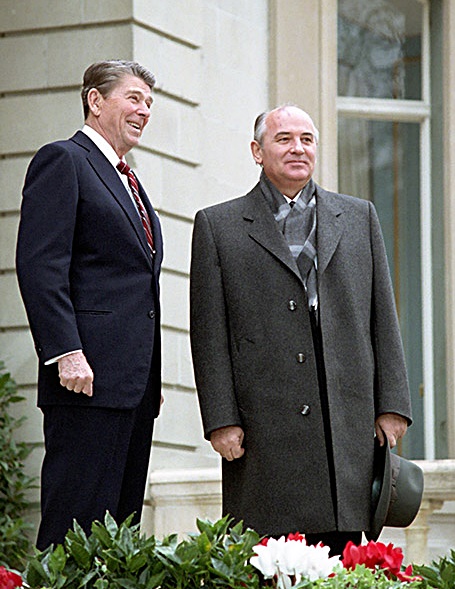
Yet Gorbachev was very different from his predecessors. Strongly influenced by earlier trips to the West and leftist writings from outside the Eastern Bloc, he came to reject key tenets of Soviet Cold War thinking, including the very idea of the East-West divide itself. He also sought to liberalize increasingly stagnant Soviet political and economic structures with the programs Glasnost, meaning openness, and Perestroika, meaning restructuring. The former was a potent if ambiguous promise of greater freedom of speech and transparency of state activity; the latter involved introducing an electoral component to politics and market reforms to the economy.
Gorbachev built up a rapport with Reagan over a series of summits, and they signed the Intermediate Nuclear Forces Treaty in 1987, committing both countries to the elimination of tactical nuclear weapons. Then, in 1988, he unilaterally and unexpectedly announced a huge scaling back of the Soviet military presence in Eastern Europe.
This marked a sea change in Soviet policy towards its Warsaw Pact allies. In 1968, after the Soviet Union had invaded Czechoslovakia to overthrow its reformist government, the then Soviet leader Leonid Brezhnev retrospectively justified this by presenting the abandonment of communism by any member of the Pact as a threat to the security of all members, thereby overriding principles of self-determination and national sovereignty. This outlook came to be known as the “Brezhnev Doctrine” and continued to shape Soviet foreign policy into the 1980s.
By abandoning the capacity to intervene forcefully in the Soviet allies’ affairs, Gorbachev was patently renouncing that earlier stance in a manner that neither its allies nor Western governments could dismiss. The new approach was humorously dubbed the “Frank Sinatra Doctrine” by Soviet Foreign Ministry spokesperson Gennadi Gerasimov on American television in November 1989, in that its various other members were now free to do things their way. It gave a major impetus to the pro-democracy movements across the Eastern Bloc, who could now challenge the authority of their failing, increasingly unpopular communist governments without being as fearful of the specter of Soviet military might in response.
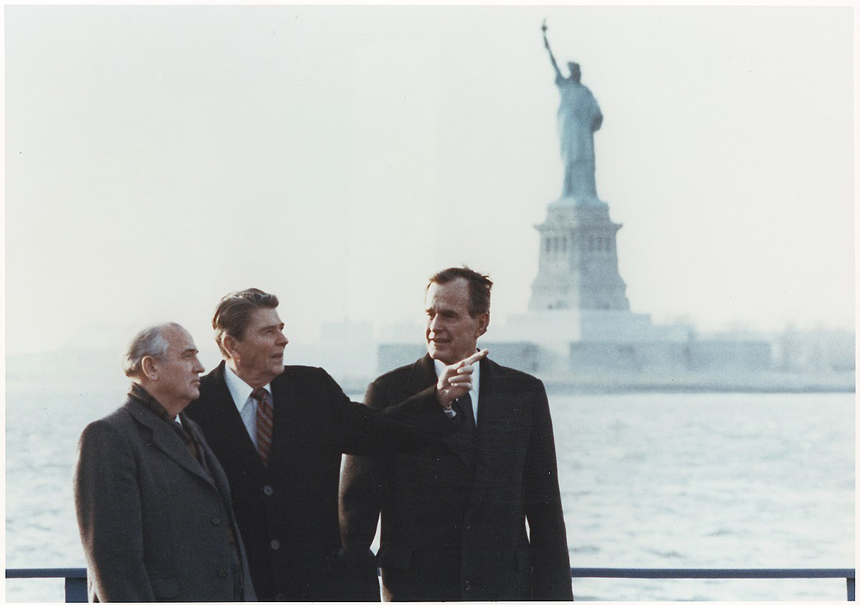
By 1989, therefore, the Cold War seemed almost over, and the future of Europe – including still divided Germany – seemed hopeful if uncertain. Gorbachev had begun to use the phrase “Common European Home” to describe his view of the continent: one in which the presence of two different political systems need not entail their being opposed to each other.
He gave the most detailed outline of this vision in a speech to the Council of Europe in Strasbourg on July 6 that year. Europeans, Gorbachev told those present, needed to work together to address their shared problems, and for the greater good of all humanity. The continent could not be united by force, and its diversity should be celebrated along with its commonalities. Gorbachev insisted:
I do not claim to carry a finished blueprint of that home in my pocket…what we have in mind is a restructuring of the international order existing in Europe that would put the European common values in the forefront and make it possible to replace the traditional balance of forces with a balance of interests.
This would be achieved through continued dialogue over largescale disarmament, including reductions in conventional as well as nuclear weapons, reinforced through cooperation on economic, political, scientific, and environmental issues. He also stressed that socialism and the Soviet Union had their place in the Common European Home and was at pains to connect the ideal with Perestroika.
Former Vice President George H. W. Bush had by this point succeeded Reagan at the White House. Though skeptical of the viability of Gorbachev’s reforms and concerned about the durability of his leadership of the Soviet Union, the Bush administration publicly committed to supporting his approach, fearing the alternatives of reversion to hardline Soviet policies or of unconstrained revolution across Eastern Europe.
Nonetheless, Bush’s prudence did not stop him from trying to exert some control over the narrative as to what was taking place, given mounting levels of excitement and optimism across Europe. He had already laid out his own vision for the continent’s future at a visit to Mainz in West Germany on May 31, 1989. In a bullish speech to an audience that included West German Chancellor Helmut Kohl, he paid particular attention to the changes sweeping across the communist world and their implications. Bush remarked:
For forty years, the seeds of democracy in Eastern Europe lay dormant, buried under the frozen tundra of the Cold War. And for forty years, the world has waited for the Cold War to end. And decade after decade, time after time, the flowering human spirit withered from the chill of conflict and oppression; and again, the world waited. But the passion for freedom cannot be denied forever. The world has waited long enough. The time is right. Let Europe be whole and free.
To achieve this, he proposed strengthening political pluralism and free elections in Eastern Europe, making East as well as West Berlin a free city, collaborating on addressing threats to the environment, and demilitarizing the continent. Bush emphasized that this was in part a response to Gorbachev’s own rhetoric, warning, “There cannot be a common European home until all within it are free to move from room to room.”
Yet the changes already afoot across Europe threatened to outpace the futures Bush and Gorbachev anticipated for the continent. Not only the Soviet Union, but also Poland and Hungary were already undergoing significant processes of political liberalization. Then on November 9, 1989, the economic and political collapse of East Germany culminated in the opening of the Berlin border. The more repressive regimes of Czechoslovakia and Romania would likewise be hastened to their demise by domestic revolutions before 1989 was out.
This was the backdrop against which Gorbachev and Bush had their first summit meeting, aboard the Soviet cruise ship Maxim Gorky, just off the Maltese coast, on December 2 and 3. Events in Europe were but one part of a wide-ranging discussion that also encompassed the economic and political changes taking place in the Soviet Union itself, and other global hotspots including Central America and the Middle East.
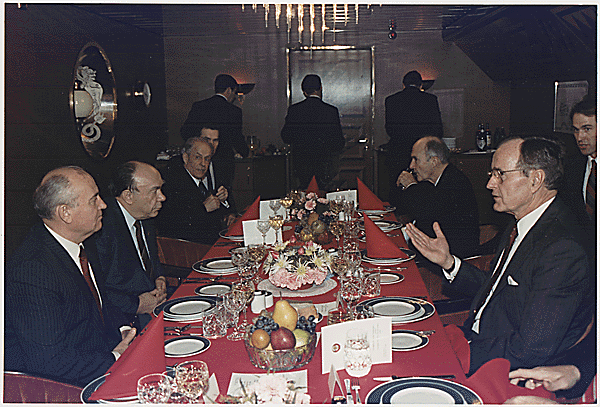
The Soviet leader spoke of the transformations occurring not only in Eastern but also Western Europe, where the Single European Act of 1986 laid the groundwork for the establishment of a single market and closer political coordination. He situated these developments within the context of his Common European Home idea, where European countries would organically draw closer together and become more compatible. Gorbachev balked at the claims made by some American politicians – he did not specify which – that this would occur based on “Western values” and warned that at such a momentous and volatile phase of history, it was risky to try and force processes – such as potential German reunification – for the sake of temporary advantage, rather than allow them to occur organically.
Bush promised that the U.S. had no desire to provoke the Soviet Union in its relations with the states of Eastern Europe, nor to put undue pressure in bringing about German reunification. He also insisted that any talk of “Western values” was not intended to promote a U.S. agenda. “A Western value is Glasnost – openness – it isn’t our word, but we value lively debate, pluralism and openness,” he explained. Gorbachev and his colleagues remained unconvinced that these things were particularly Western, but both sides agreed that the importance lay in the shared principles rather than in how they were labelled.
The Malta Summit seemed to herald a breakthrough in American-Soviet and broader East-West relations. It seems a moment far removed from the present. Fledgling democracy in post-Soviet Russia has long since eroded under Vladimir Putin’s perpetual leadership. Many of its neighbors, including other former Soviet republics, have joined or applied to join the European Union and NATO, partly as a bulwark against Russian threats.
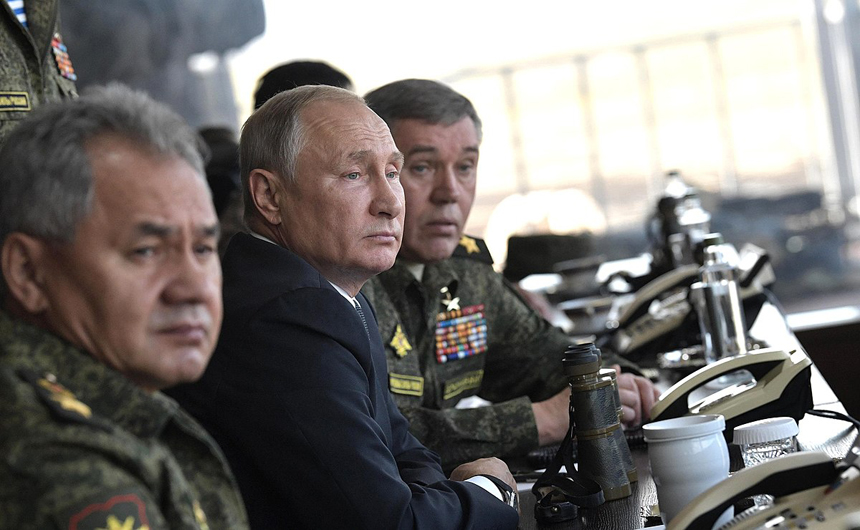
Far from Gorbachev’s Common European Home, Putin’s Russia has re-embraced a Eurasian destiny. Following the break-up of the Soviet Union in 1991, the idea took hold among some of the country’s elites that Russia and its former empire had, despite their ethnic, linguistic, and religious differences, some common Eurasian characteristics that pitted them in opposition to Western liberal values and their perceived accompanying hypocrisies of celebrating freedom and equality and a rules-based international order while practicing racial discrimination and colonization. This belief in a Russian mission to function as an imperial power and bulwark against Western domination has strongly informed Russian domestic and foreign policy, including its full-scale invasion of Ukraine in 2022.
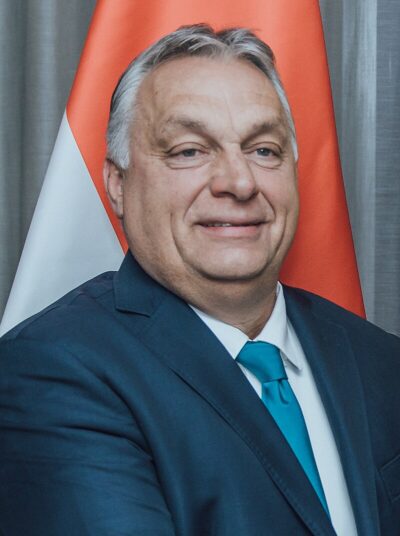
Yet at the same time, the notes of caution Gorbachev struck in 1989 when talking about Europe’s future seem rather prescient. The speed of economic change in the former Soviet Union and Eastern Bloc, welcomed and encouraged by the U.S. and its Western European partners, often did not secure the establishment of democracy there. These painful experiences, including the near collapse of the Russian economy in the late 1990s and the perception of Western triumphalism and hypocrisy, helped legitimize Putin’s foreign policy aggression and his suppression of domestic opposition.
Western politicians and intellectuals, by contrast, routinely continue to claim a monopoly on liberal democratic ideals, but the recent electoral success of far-right parties across the continent illustrates that they do not necessarily hold a monopoly in European societies.
Bush’s vision of a Europe “whole and free” may well have won out over Gorbachev’s “Common European Home” in the short term, but its long-term durability seems, worryingly, far more open to question.
Become a Saturday Evening Post member and enjoy unlimited access. Subscribe now



